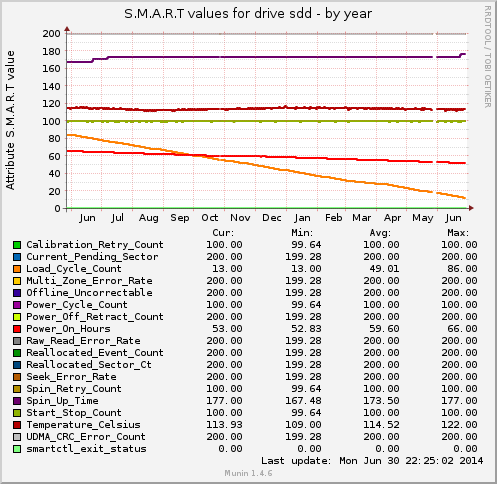Today when looking at my Munin graphs for S.M.A.R.T. values of my always-on PVR box, I noticed that within a year, my Western Digital Green-line disks had degraded their Load_Cycle_Count attribute to a shocking low level of below 20 (in S.M.A.R.T., low levels are bad). The raw value indicated that the three of the four disks had parked their heads more than a half million times, each:
#$ for D in sda sdb sdc sdd; do sudo smartctl -A /dev/$D | grep "^193"; done
193 Load_Cycle_Count 0x0032 014 014 000 Old_age Always - 559966
193 Load_Cycle_Count 0x0032 200 200 000 Old_age Always - 111
193 Load_Cycle_Count 0x0032 010 010 000 Old_age Always - 572713
193 Load_Cycle_Count 0x0032 013 013 000 Old_age Always - 563615
Munin’s year graph for one of the disks showed shocking truth, the disk was aging fast:
When watching the above shell script with watch over time, I noticed, that some of the disks parked their heads about 2-3 times per minute. As the machine is always on, this sums up pretty quickly.
Research soon got me to several blog posts and forum discussions of the issues. Western Digital itself recommends using hdparm to disable advanced power management of the disk. This seems to be unsupported, by my drives, though.
Another way provided by WD, which has been often recommended, was downloading a DOS tool from Western Digital to set the idle timer of the disks. Not really the way I wanted to go.
Fortunately, I also found a blog entry that directed me to the idle3 project, that provides a way to set it from Linux.
The tool was very easy to compile (just one call to make), and then provided me with the current settings:
#$ for D in sda sdb sdc sdd; do sudo ./idle3ctl -g /dev/$D; done
Idle3 timer set to 80 (0x50)
Idle3 timer set to 80 (0x50)
Idle3 timer set to 80 (0x50)
Idle3 timer set to 80 (0x50)
Disabling the timer was easy enough for all four drives:
#$ for D in sda sdb sdc sdd; do sudo ./idle3ctl -d /dev/$D; done
Idle3 timer disabled
Please power cycle your drive off and on for the new setting to be taken into account. A reboot will not be enough!
Idle3 timer disabled
Please power cycle your drive off and on for the new setting to be taken into account. A reboot will not be enough!
Idle3 timer disabled
Please power cycle your drive off and on for the new setting to be taken into account. A reboot will not be enough!
Idle3 timer disabled
Please power cycle your drive off and on for the new setting to be taken into account. A reboot will not be enough!
The warning should be taken seriously though, the command took only effect after powering the whole system down, even though the drive itself reported idle timer to be disabled right away.
Update 2019-07-13: As I needed to adjust the IDLE mode of one of my Western Digital Red (WD30EFRX-68EUZN0) drives, I found out that more recent versions of hdparm support getting/setting the mode, even via certain USB adapters. This was a huge improvement for me, since the tool mentioned above requires the drive directly attached to a SATA port, which always required shutting down the PC and re-wiring the disks for changing the settings. The relevant command is as follows (replace it with your appropriate device). And yes, you need the scary parameter.
hdparm -J 0 --please-destroy-my-drive /dev/sde
It is still necessary to power down the device before the setting takes effect.
